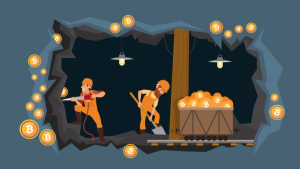
Actors in the blockchain space are constantly buying, selling and sending billions of dollars worth of cryptocurrencies. Accordingly, the millions of transactions that are happening need record keepers to account for issues such as double-spending complications [1]. For those who send digital assets with Proof-of-Work (PoW) consensus mechanisms, they need certain participants, also known as miners, to confirm these transactions and add them into the blocks of a ledger (blockchain) in a decentralized way. This process is widely known as cryptocurrency mining [2].
In layman terms, once a block (bundle of transactions) is created, it undergoes a verification process. Miners take the information within the block, namely the actual block data, previous block data, current time and nonce, and apply a mathematical formula to it. This results in the seemingly random sequence of characters (letters and numbers) commonly known as a hash.
Hashes are functions that encrypt data into a sequence of characters. They have the necessary cryptographic characteristic that makes it easy to produce its desired output, while simultaneously making it virtually impossible to reverse engineer the data (you can’t find out the encrypted original data with only the hash information). Each hash is unique to the input it takes, so even the slightest change in the input will result in a completely different hash. For example, the input “Bitcoin” will have a different hash output to the input “bitcoin,” despite the small distinction between the two words.
The importance of hashes in mining
Why are hashes important? In blockchain, each hash takes as input the hash of the previous block (think of them as pointers to the previous/next block), so if anyone tries to change the information (hash) of any given block in the chain, every following block will also deterministically change its hash, and will therefore be rejected by the rest of the nodes in the chain. This bestows the core principle of immutability to a blockchain, and is one of the most revolutionary advances in cryptography.
Anyone with access to the blockchain hash function can check the authenticity of each block, and find out if the hash is different from the one stored. Therefore, they are able to instantly spot invalid blocks as fake.
Cracking the puzzle of cryptocurrency mining
The difficulty of the Proof of Work mathematical puzzle is adjusted every two weeks, which results in an average block creation rate of six times per hour (1 every 10 minutes, which is the average block time). Furthermore, its complexity depends directly on the amount of nodes (computers that run the blockchain software) in a network. That is also the reason why a higher number of nodes makes a blockchain more secure.

Source: DGS101 [3]
Once a cryptocurrency miner solves the puzzle and publishes to the network, the other nodes automatically check its validity; this happens almost instantaneously once they have the resulting nonce. If actually valid, the miner receives a network reward, and the cycle starts all over again. Because the rest of the miners receive nothing, making their efforts momentarily ‘futile,’ it is common for small, starting miners to pool together in order to improve their odds of success, thus creating ‘mining pools’.
Conclusion
At Scalable Solutions, we offer white-label exchange software for digital assets, making access to thousands of cryptocurrencies as simple and user friendly as it can be. Through our services, we also encourage blockchain adoption; we will continue to develop different tier articles, from introductory pieces to in-depth analysis, helping our readers get familiar with this asset class that has the potential to disrupt many aspects of our lives.
References
[1] Reiff, Nathan. “How Does a Block Chain Prevent Double-Spending of Bitcoins?” Investopedia, 9 Feb. 2021, www.investopedia.com/ask/answers/061915/how-does-block-chain-prevent-doublespending-bitcoins.asp.
[2] “Staking – A Powerful Feature .” Resources, Scalable Solutions, 3 Nov. 2020, scalablesolutions.io/news/staking-a-powerful-feature/.
[3] Jeyflex. “Why Do We Need Miners?” MINING, 6 Sept. 2018, dgs101.blogspot.com/2018/09/mining.html.
Sources
Arora, Shivam. “Bitcoin Mining Explained – The 2021 Edition.” Simplilearn, 30 June 2021, www.simplilearn.com/bitcoin-mining-explained-article.
Hong, Euny. “How Does Bitcoin Mining Work?” Investopedia, 21 June 2021, www.investopedia.com/tech/how-does-bitcoin-mining-work/.

